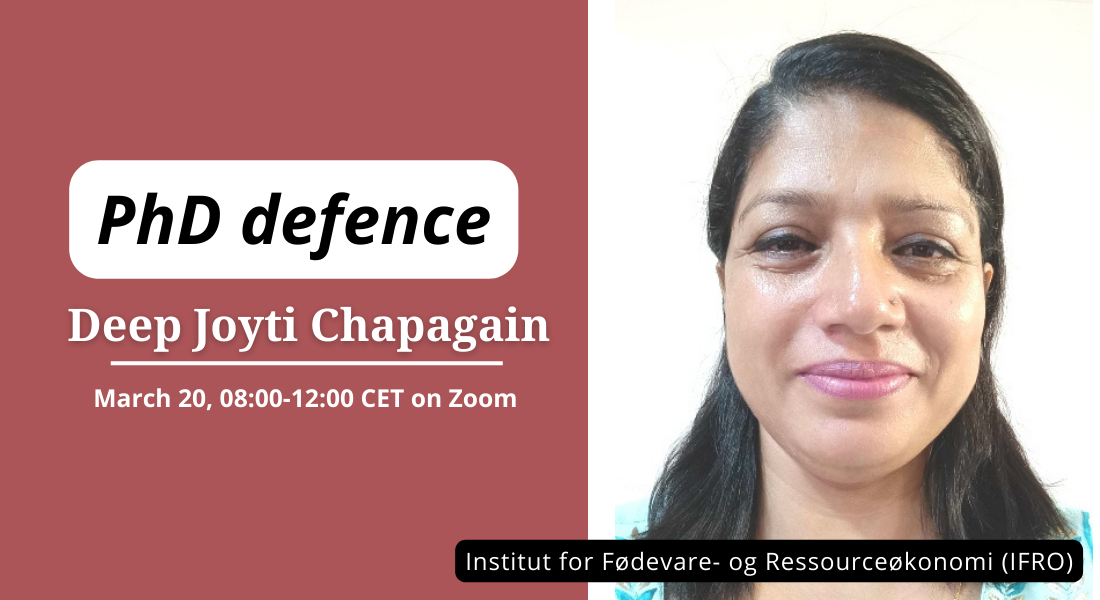
PhD defence: Population Ecology and Harvesting Sustainability in Nepalese Himalaya

PhD defence
Deep Joyti Chapagain
Abstract
The harvesting of Medicinal and Aromatic Plants (MAPs) is a customary subsistence activity of forest-dependent communities across the world. However, the harvesting and marketing of MAPs has been highly commercialized in recent years, leading to the colossal pressures on the MAPs resource base.
Many MAPs like Aconitum spicatum and Dactylorhiza hatagirea have been threatened in the Himalaya due to unsustainable harvest. At the same time, scientific knowledge on the demographic properties, magnitude of harvest impact, and the long-term viability of populations of these plant species is largely lacking thus limiting our ability to develop sustainable management strategies.
Thus, this research was designed to understand the population ecology and harvesting sustainability of A. spicatum and D. hatagirea in the Annapurna Conservation Area and Manang in Central Nepal, and Darchula in Western Nepal.
Different levels of tuber harvesting (0%, 25%, 50% and 75%, where 0-25% represents low harvest intensity and 50-75% represents high harvest intensity) were applied directly by the locals for A. spicatum among three ecotonal populations (subalpine,lower alpine and alpine) along an elevation gradient (3000–4200 m a.s.l.) in Annapurna Conservation Area, North-Central Nepal. For D. hatagirea, two sites were selected: Manang, where harvesting of MAPs was locally regulated (protected); and Darchula, where harvesting was locally unregulated (unprotected) to see the effect of harvesting on its demographic parameters.
Population density and structure of A. spicatum was studied and variation in its life history traits among three populations along the elevation gradient in Central Nepal was assessed.
The results showed that human disturbances and topographic factors greatly contributed to the variation in density and life history traits. The overall density ranged between 0.56 ± 0.09 (mean ± SE) and 2.48 ± 0.24 plants/m2 with highest mean density in the lower alpine and lowest in the subalpine population. Harvesting, animal droppings and fire appeared to be the most important factors affecting density of A. spicatum at its different life stages.
The demographic data of A. spicatum included 4-year observations on growth, fecundity and survival of individuals classified by size. The population dynamics of xi A. spicatum in three different populations along the elevation gradient in Annapurna Base Camp Region, North-Central Nepal was studied.
The population growth rate (l) was >1 in low harvest intensity (0-25%) in all the populations in all the transitions (2015-2018) indicating that the harvesting of this plant at low harvest intensity is sustainable. In the high harvest intensities (50-75%), the lambda value was <1 in lower elevation populations indicating that these populations are sensitive to high harvest. The results showed that the extinction probability derived from the stochastic simulation (1000 runs) in 100 years has extremely low value for all the populations in both the intensities.
Transient dynamics revealed that the low harvested alpine population shows gradual increase in its population reaching a size of approximately 4000 individuals during the projection period of 10 years.
The deterministic projection revealed that the subalpine population is the most sensitive population. The populations of subalpine (both low harvest and high harvest) can reach the low harvest intensity of alpine in more than 20 years.
The high harvest population of subalpine requires 22 years to reach its low harvest intensity in contrast to 7 years of lower alpine. The higher contribution of large size classes to l indicates that the larger size classes are the critical stages in the life cycle of A. spicatum and conservation priority should focus on the protection of theses stages.
Population density, structure, and tuber biomass of D. hatagirea were studied and compared in seven different populations. Mean density of D. hatagirea was significantly higher in the locally protected (1.31 ± 0.17 plants/m2) than in the unprotected (0.72 ± 0.06 plants/m2) site.
The protected site showed stable population density with high reproductive fitness and tuber biomass over the three-year period. The densities of different life-stages were highly sensitive to harvesting and livestock grazing.
Significant interactions between site and harvesting and grazing indicated particularly strong negative effects of these disturbances on densities of juvenile and adult reproductive stages in the unprotected site.
A matrix population model was prepared to explore variation in demographic parameters in response to different level of disturbances. In case of D. hatagirea, demographic data included 2-year observations on growth, fecundity and survival of individuals classified by size.
Transition probabilities for stage-based population projection matrices varied between populations and among years.
The population growth rate (l) was less than 1in unprotected (Darchula) and more than 1 in protected (Manang) site. The unprotected populations can resume its sustainable growth at 10- fold increase in its present fecundity while the present protected populations would allow approximately 10% of the populations to be harvested locally maintaining sustainability. The wetland population requires 25-fold increase in its present fecundity to maintain the stable size. Elasticity analysis shows that the juvenile and reproductive adult stages are the critical life stages of D. hatagirea in unprotected and protected site respectively and should be conserved with greater priority.
Semi-structured interviews were conducted with informants (n = 65 for A. spicatum and n = 186 for D. hatagirea) in the villages and at the ecological survey sites. The result shows that the population of A. spicatum is decreasing due to indiscriminate harvesting by the outsiders and the locals are highly responsible for the conservation of A spicatum of that area. In case of D. hatagirea, populations at the protected site are well maintained with almost constant density over years but populations at unprotected sites greatly fluctuated in density.
It is concluded that the long-term viability of A. spicatum and D. hatagirea largely depends on the magnitude of harvest impact and the level of protection provided directly by local people; and the opportunities of sustainable harvest vary among plant species with different strategies of growth and demographic properties, and these further relate with ecological conditions set by elevation gradient. Sustainability of harvest of A. spicatum and D. hatagirea can be achieved through integrating species specific ecological studies, and knowledge and practices of key knowledge holders.
The findings of this research suggest that strategies and actions towards reducing human induced disturbances like over-harvesting and grazing would greatly benefit population recovery and productivity of theses plant species.
Supervisor
Professor Henrik Meilby, Department of Food and Resource Economics (IFRO), University of Copenhagen
Co-supervisor
Professor Dr. Suresh Kumar Ghimire, Central Department of Botany, Tribhuvan University, Nepal
Assessment Committee
Chair:
-
Professor Ida Theilade, Department of Food and Resource Economics, University of Copenhagen
-
Professor Christian Frølund Damgaard, Aarhus University, Department of Ecoscience, Terrestrial
-
Professor emeritus Santosh Rayamajhi, Tribune University, Institute of Forestry, Pokhara, Nepal
Master of Ceremony
Associate Professor Thorsten Treue, Department of Food and Resource Economics (IFRO), University of Copenhagen
The defence is online and open to all.
To participate, you need to sign up for a link and passcode for Zoom:
Please contact Deep Joyti Chapagain chapagaindeep@gmail.com before 19 March 2024 – 11:00 (CET).
If you are interested in a full copy of the thesis, please contact the PhD student or the PhD Secretary.
Events


